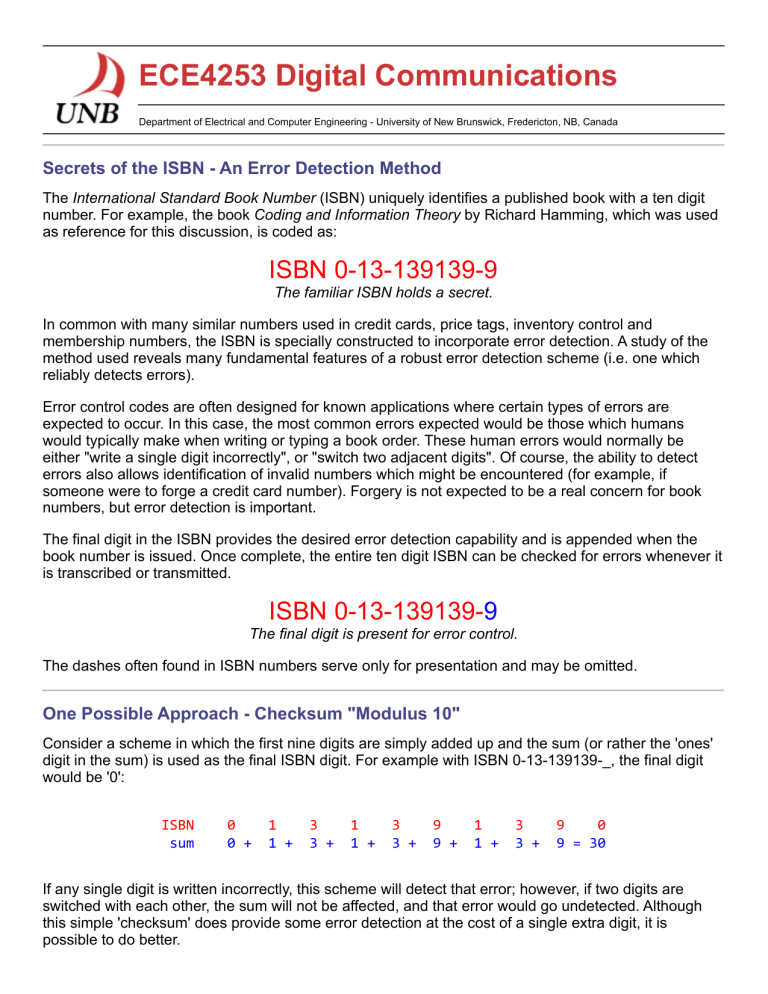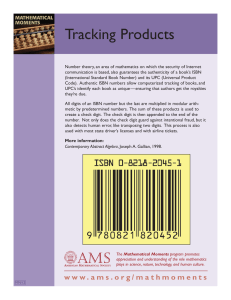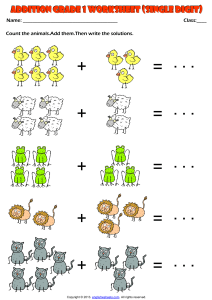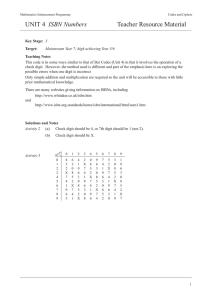
ECE4253 Digital Communications
Department of Electrical and Computer Engineering - University of New Brunswick, Fredericton, NB, Canada
Secrets of the ISBN - An Error Detection Method
The International Standard Book Number (ISBN) uniquely identifies a published book with a ten digit
number. For example, the book Coding and Information Theory by Richard Hamming, which was used
as reference for this discussion, is coded as:
ISBN 0-13-139139-9
The familiar ISBN holds a secret.
In common with many similar numbers used in credit cards, price tags, inventory control and
membership numbers, the ISBN is specially constructed to incorporate error detection. A study of the
method used reveals many fundamental features of a robust error detection scheme (i.e. one which
reliably detects errors).
Error control codes are often designed for known applications where certain types of errors are
expected to occur. In this case, the most common errors expected would be those which humans
would typically make when writing or typing a book order. These human errors would normally be
either "write a single digit incorrectly", or "switch two adjacent digits". Of course, the ability to detect
errors also allows identification of invalid numbers which might be encountered (for example, if
someone were to forge a credit card number). Forgery is not expected to be a real concern for book
numbers, but error detection is important.
The final digit in the ISBN provides the desired error detection capability and is appended when the
book number is issued. Once complete, the entire ten digit ISBN can be checked for errors whenever it
is transcribed or transmitted.
ISBN 0-13-139139-9
The final digit is present for error control.
The dashes often found in ISBN numbers serve only for presentation and may be omitted.
One Possible Approach - Checksum "Modulus 10"
Consider a scheme in which the first nine digits are simply added up and the sum (or rather the 'ones'
digit in the sum) is used as the final ISBN digit. For example with ISBN 0-13-139139-_, the final digit
would be '0':
ISBN
sum
0
0 +
1
1 +
3
3 +
1
1 +
3
3 +
9
9 +
1
1 +
3
3 +
9
0
9 = 30
If any single digit is written incorrectly, this scheme will detect that error; however, if two digits are
switched with each other, the sum will not be affected, and that error would go undetected. Although
this simple 'checksum' does provide some error detection at the cost of a single extra digit, it is
possible to do better.
Modulus Arithmetic
Note that taking only the last digit in a decimal number is equivalent to dividing the number by 10 and
using only the remainder. This result is also referred as to the sum modulo 10 and is generally written
as a congruence relationship:
30 ≡ 0 (mod 10)
After division by 10, the remainder is 0.
Using MATLAB, the modulo 10 operation is mod(x,10) and is equivalent to finding the remainder after
division by 10 as rem(x,10). In the above example, mod(30,10) returns 0. The required checksum
digit may be found as:
>> checksum = mod( sum([0 1 3 1 3 9 1 3 9 0]), 10 )
How ISBN Actually Works
If a 'weighted sum' is constructed by multiplying each digit by a different constant, the problem of
swapped digits going undetected can be eliminated. Furthermore, the final digit will be computed so
that the weighted sum is an exact multiple of 11. In other words, the final digit is computed such that
the sum 'modulo 11' equals zero. In this case, 143 is an exact multiple of eleven (143 = 13 × 11).
ISBN
multiplier
sum
0
1
3
1
3
9
1
3
9
9
x10
x9
x8
x7
x6
x5
x4
x3
x2
x1
----------0 + 9 + 24 + 7 + 18 + 45 + 4 + 9 + 18 + 9 = 143
143 ≡ 0 (mod 11)
The ISBN is correct if a zero result is obtained.
Note that the remainder of division by eleven could be any number from 0 to 10. If it happens that the
value of the check digit must be 10, the letter 'X' is used instead to complete the ISBN.
When compared to the previous (modulo 10) example, the cost of having error control is still only one
extra digit yet this method is more performant and can detect swapped digits as well as wrong digits.
The objective of error control theory is to achieve the best performance at the least cost.
Using MATLAB, the above number could be checked as the weighted sum:
>> check = mod( sum([0 1 3 1 3 9 1 3 9 9].*[10 9 8 7 6 5 4 3 2 1]), 11 )
Why Modulo 11?
To explore the logic behind choosing 11 as a modulus, apply the above algorithm using 'modulo 5',
ISBN
multiplier
sum
0
1
3
1
3
9
1
3
9
1
x10
x9
x8
x7
x6
x5
x4
x3
x2
x1
----------0 + 9 + 24 + 7 + 18 + 45 + 4 + 9 + 18 + 1 = 90 = 0 (mod 5)
Two observations can be made:
1. The final digit could be either 1 or 6 and still give 0 (mod 5).
2. The digit 9 (highlighted) could be anything and still give 0 (mod 5).
It is clear that a digit greater than 10 must be used. As a final experiment, repeat the above algorithm
using 'modulo 12',
ISBN
multiplier
sum
0
1
3
1
3
9
1
3
9
X
x10
x9
x8
x7
x6
x5
x4
x3
x2
x1
----------0 + 9 + 24 + 7 + 18 + 45 + 4 + 9 + 18 + 10 = 144 = 0 (mod 12)
This does not work perfectly either:
1. The final digit 9 could be 9 - 6 = 3 and the result would be 132 = 0 (mod 12)
2. The final digit 3 could be 3 + 4 = 7 and the result would be 156 = 0 (mod 12)
In either case, the error would go undetected because 12 has factors (1,2,3,4,6) and any of these digit
positions could contain a different digit which gives some other multiple of 12.
This problem be overcome by using a prime integer for the modulus. With no alternate method of
obtaining a result which is an exact multiple of 11, the ISBN is guaranteed to detect all single-digit
errors and all swapped-digit errors. Only the choice of a suitable prime modulus assures this result. Of
note, the set {0,1,2,...,10} modulo 11 defines a finite field GF(11) under normal addition and
multiplication operations.
Using MATLAB, the contribution of every digit to the total sum can shown in a table as:
>> table = mod( [1:10]' * [0:9], 11 )
For an error to be detected, the sum (modulo 11) must change when a digit changes. In this table,
every row contains ten distinct values, so any change of a single digit at a given ISBN position would
necessarily be detected.
DIGIT
0
1
2
3
4
5
6
7
8
9
Contribution (x1)
0
1
2
3
4
5
6
7
8
9
Contribution (x2)
0
2
4
6
8
10
1
3
5
7
Contribution (x3)
0
3
6
9
1
4
7
10
2
5
Contribution (x4)
0
4
8
1
5
9
2
6
10
3
Contribution (x5)
0
5
10
4
9
3
8
2
7
1
Contribution (x6)
0
6
1
7
2
8
3
9
4
10
Contribution (x7)
0
7
3
10
6
2
9
5
1
8
Contribution (x8)
0
8
5
2
10
7
4
1
9
6
Contribution (x9)
0
9
7
5
3
1
10
8
6
4
Contribution (x10) 0 10
9
8
7
6
5
4
3
2
TWO DIGITS EXCHANGED
Swapping two digits (i.e. 34 becomes 43) is a common error made by humans when transcribing
numbers such as the ISBN.
Swapping two digits is a special case of two single digit errors. For an error to be detected, the sum
(modulo 11) must change when two digits are swapped. Inspection of the above table shows that every
column contains eleven distinct values, with the exception of the column for the digit 0. (Only the digit 0
would give the same contribution to the sum if it moves to a different ISBN position.)
Let the two digits be A and B let them be at position (multiplier) N and N+1 respectively.
The contribution of this (A,B) to the correct sum is C0 = AN + B(N+1). If the two are swapped, their
contribution becomes C1 = BN + A(N+1). In other words when these digits are exchanged, the ISBN
sum simply changes by C1 - C0 = (A - B), regardless of where in the number these two adjacent digits
appear. Since an ISBN error will go undetected only if the sum changes by a multiple of 11 ,and since
the difference (A-B) can never equal 11, then adjacent swapped digits will always be detected.
In this example, the sum 143 changes to 149 when the digits 3 & 9 (highlighted) are swapped. The
error is detected.
ISBN
multiplier
old sum
new sum
0
1
3
1
[3]
x10
x9
x8
x7
x6
-----0 + 9 + 24 + 7 + 18 +
0 + 9 + 24 + 7 + 54 +
[9]
1
3
9
9
x5
x4
x3
x2
x1
-----45 + 4 + 9 + 18 + 9 = 143
15 + 4 + 9 + 18 + 9 = 149
149 ≡ 6 (mod 11)
The error is detected.
Further analysis shows that for two digits separated by a distance M the difference will be M(A-B),
which can never be a multiple of eleven for M less than eleven. (Adjacent digits are the special case of
M=1.) Again, this works well because 11 is a prime number. Consequently, the exchange of any two
digits in the ISBN would always be detected.
RULE FOR CHOOSING A MODULUS
It follows that the choice of 11 is a consequence of three rules:
1. The modulus must be greater than the number of digits in the ISBN.
2. The modulus must be greater than the range of digits in each position.
3. The modulus must be a prime integer.
WORST CASE PERFORMANCE
If an ISBN is totally garbled (or forged!), the use of modulus 11 implies that there is one chance in
eleven that the (random) number will nonetheless pass the error detection test. Conversely, there are
10 chances out of 11 that the error will be detected. Consequently, while single-digit errors and
swapped digits can be detected with 100% certainty, other types of errors should be detected with
10/11 = 91% reliability.
The properties of the ISBN can be explored further using the EE4253 Online ISBN Checking Tool.
Conclusions
A systematic approach to error detection can lead to better codes. Both the simple checksum and the
ISBN method involve adding only one additional digit, yet the ISBN method is more effective.
The use of a prime modulus is illustrated by the ISBN coding method. This observation is important in
error control coding, and it lays the groundwork for more sophisticated approaches involving long
binary messages.
Example 1
Check the number ISBN 0-07-007013-X
ISBN
multiplier
sum
0
0
7
0
0
7
0
1
3
X
x10
x9
x8
x7
x6
x5
x4
x3
x2
x1
----------0 + 0 + 56 + 0 + 0 + 35 + 0 + 3 + 6 + 10 = 110
Recall that 'X' used when '10' is required in the final digit.
Since 110 ≡ 0 (mod 11), this ISBN is correct.
Example 2
Complete the number ISBN 1-55512-010-_
ISBN
multiplier
sum
1
5
5
5
1
2
0
1
0
?
x10
x9
x8
x7
x6
x5
x4
x3
x2
x1
----------10 + 45 + 40 + 35 + 6 + 10 + 0 + 3 + 0 + ? = 149
Since 149 is not a multiple of 11, and the next closest multiple is 14x11= 154, the final digit should be
5.
Sum = 154 ≡ 0 (mod 11), for the valid ISBN 1-55512-010-5
Sat Mar 9 23:32:50 AST 2024
Last Updated: 08 MAR 2015
Richard Tervo [ tervo@unb.ca ]
Back to the course homepage...



